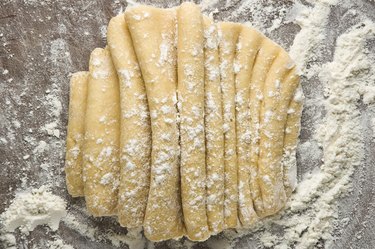
Almost any grain you can grind into flour you can turn into pasta, but two main types of flour are used for the pasta we know and love: hard-durum wheat flour, or semolina, and hard winter wheat, or bread flour. Alternative flours for pasta, such as whole-wheat or gluten-free are usually a mix of more than one type of flour. Flavored pastas break the norm with the addition of pastes or purees.
Durum Wheat Semolina and Dried Pasta
Video of the Day
Pasta secco, or dried pasta, is made from semolina. Semolina has more protein than other wheat flours and its gluten behaves differently and has more strength than the gluten in other flours, making it the logical choice for dried pasta. Semolina's gluten doesn't stretch like other types of gluten do, so it retains its structure longer and doesn't turn into a loose boiled dough when you cook it. Dried semolina pasta is a true Italian staple because of its versatility and ability to reach the coveted al dente stage, where the pasta is soft on the outside with the tiniest hint of a bite at the center. When buying dried pasta, make sure it is made from 100 percent durum wheat semolina.
Video of the Day
Bread Flour and Fresh Pasta
Fresh pasta, or pasta fresca, is made from the flour of hard wheat varieties, such as hard red winter wheat. Bread flour has high protein and high gluten content, like semolina, but its gluten responds to heat differently. Despite its name, hard wheat flour's gluten has a lot of elasticity and stretches more than the gluten in semolina, which also limits its strength. That's why fresh pasta turns to mush faster when you overcook it than dried pasta does, and why you can never cook it to a firm, toothy al dente stage. Although limited, fresh pasta has its place. Some dishes, such as fresh squid ink pasta dressed with garlic and olive oil, are impossible with dried pasta, and other dishes rely on its smooth, soft texture.
Flavored Pasta Flour Types
Flavored pastas, such as spinach, beet and tomato, have a puree or paste of the flavoring ingredient incorporated during production. The flour used depends on the pasta's form: Fresh noodles use bread flour while dried flavored pastas use semolina. You can make your own fresh flavored pasta by cooking and pureeing 1 cup of the vegetable of your choice then mixing it in with one additional egg yolk after it cools. Then, add the egg yolk to a standard fresh pasta recipe.
Alternative Pasta Flours
Nontraditional pastas include whole-wheat and gluten-free varieties, as well as rice- and egg-based pastas, mainly used in Asian cooking. The flour in whole-wheat pasta is usually ground from a combination of whole and hulled hard wheat, because pure whole wheat is difficult to digest. Specialty purveyors and small shops also make small batches of artisinal pastas made from barley, soy buckwheat and a host of other grains.